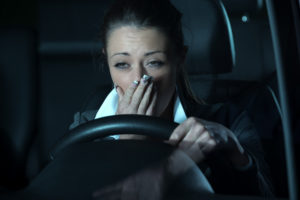
The symptoms of driver fatigue
Driver fatigue is incredibly dangerous and the primary cause of thousands of road traffic accidents every year. In fact, it is thought that 20% of accidents on the road are partly caused by driver fatigue. If you’re planning a long drive you should be aware of the symptoms of driver fatigue. Unless you have a sleep condition you will not fall asleep without warning. So paying attention to the signs and symptoms of driver fatigue can prevent you from falling asleep at the wheel. It will also prevent you from causing injury to yourself and others.
Not sleeping enough
If you’ve experienced broken sleep or feel like you haven’t slept for long enough then you are a prime candidate for driver fatigue, especially over a long journey. Some drivers when they start to feel tired try opening a window or turning the radio up. While this will help keep your eyes peeled a little longer it’s certainly not going to see you through the rest of your journey if you still have some miles to cover.
The most common times for sleep-related accidents on the roads are in the early hours of the morning and after lunch. Both common times when the average person starts to feel snoozy. The fact that 40% of sleep-related road accidents involved commercial vehicles. So if you work on the roads, it’s hugely important to ensure you get enough sleep the night before.
Taking medication

If you begin to take a new medication you should ask your doctor or pharmacist if it can make you feel drowsy. If there is even a small chance that your medication could affect your driving ability then you should avoid driving long distances. Similarly, if your doctor informs you that you cannot drive when taking your medication then you must heed this warning. If you decide to drive against the advice of your doctor then you may invalidate your insurance and you are far more likely to be involved in an accident. If you feel alert and awake a few hours after taking your medication and you haven’t received any warning about driving, then you might be ok to drive a short distance, but only if you feel confident doing so.
After drinking alcohol
Obviously, we all know that drinking and driving is a no go and that there are hefty penalties to pay if you are caught behind the wheel while intoxicated. However, the following day is a grey area for many drivers. Ideally, you shouldn’t drive 12 hours after you had your last drink. Alcohol can cause drowsiness behind the wheel, even if you’ve only had one drink at lunch time. So be extra cautious to watch for the symptoms of driver fatigue if you’ve had a drink within the last 12 hours.
After working a long shift
If you’re getting into your car to drive home after a long shift at work then your brain will be fried and your bed will be calling. Be vigilant to look out for the symptoms of driver fatigue and if possible avoid driving after a long shift.
If you’re getting into your car to drive home after a long shift at work then your brain will be fried and your bed will be calling. Be vigilant to look out for the symptoms of driver fatigue and if possible avoid driving after a long shift.
Symptoms of driver fatigue

So we know when you’re most likely to suffer from the symptoms of driver fatigue. But what are the symptoms to look out for? Fatigue is easy to detect, with symptoms including:
- Yawning
- Sore or heavy eyes
- Delayed reactions
- Daydreaming and not being conscious of your driving
- The speed you drive at creeps up or down
- Becoming impatient or irritable
- Impaired driving performance such as poor gear changes
- Stiffness and cramps
- Loss of motivation
Driving while tired or fatigued can result in some serious consequences. You will have slower reaction times meaning you can’t respond as effectively to hazards on your journey. Perhaps you will lack concentration and make judgement errors in calculating speed and distance. Poor judgement about things like pulling out of a junction which can lead to devastating accidents. Finally, of course, fatigue can result in you nodding off behind the wheel even if it’s only for a couple of seconds it can have dire consequences.
How to beat driver fatigue
Preventing driver fatigue is all about being prepared for the eventuality that you may be tired while behind the wheel at some time in your driving life. Should you become tired behind the wheel you can follow these steps to help beat fatigue and reach your destination safely.
If you’re planning a long trip make sure you can get a good night’s sleep the night before. Then, plan your route carefully. Take into account regular breaks every hour to two hours where you leave the car, stretch your legs and take a series of deep breaths to clear your mind and wake you up. Stock up on coffees and have sweets you can pick at when you feel you need a bit of a pick me up. Avoid drinking alcohol before you drive as even a small amount can significantly increase your chances of developing fatigue. If possible, sharing the driving on a long journey is preferable. This gives each driver time to relax and recoup after their driving stint. Finally, avoid travelling at times you would usually be sleeping and never drive for more than 8-10 hours per day.
Read up about driverless cars and how they can stop driver fatigue
What should I do if I start to feel fatigued behind the wheel?

There are some steps to take if you find yourself experiencing any symptoms of driver fatigue. Being aware of early signs such as yawning or rubbing your eyes should be a warning that you are becoming fatigued. When you notice these signs you should find a service station and take a break. Get yourself a coffee and take 15 minutes to just close your eyes. This should relieve you enough to carry on your journey for a while longer. If you start to experience more serious symptoms of driver fatigue such as severe drowsiness you should pull over at the nearest safe place, switch off your engine and close your eyes. A 15-20 minute power nap will give you enough oomph to continue your journey. Then, find another service station and grab yourself a coffee and something small to eat to keep you going for the next leg of your journey.
The only real cure for driver fatigue is to sleep, so all of these hints and tips will work for a short while, but ultimately the longer you continue to drive while experiencing symptoms of fatigue the more risk you are at of falling asleep at the wheel. If you plan your journey and follow the other guidelines set out in this article then you shouldn’t be too far from your destination by the time you start experiencing fatigue.
Drive safe.

